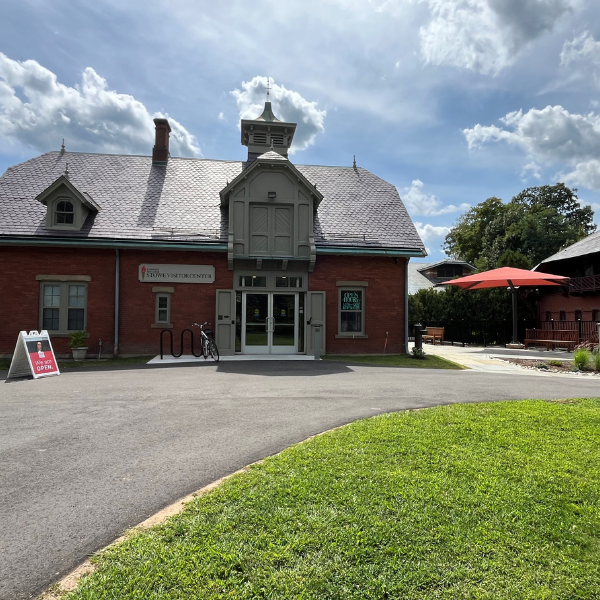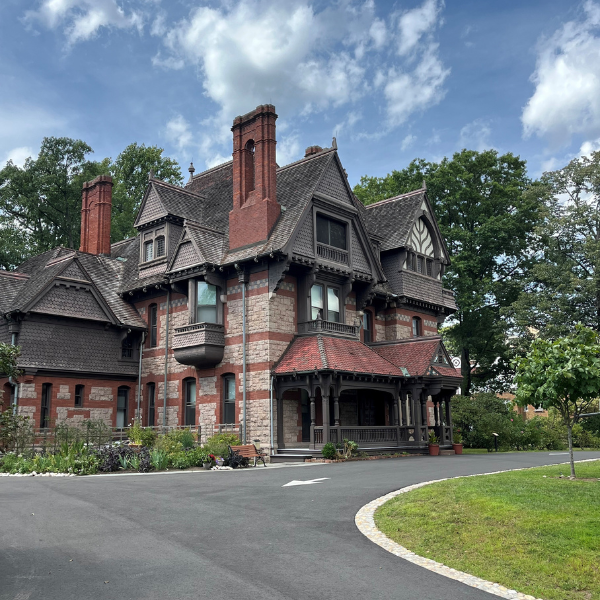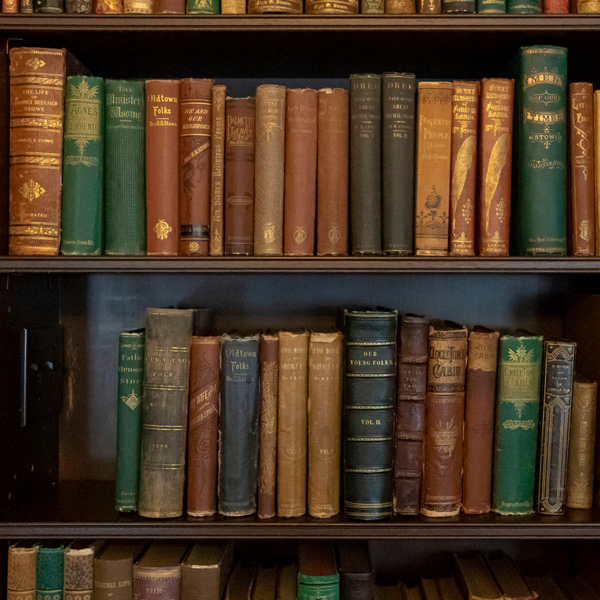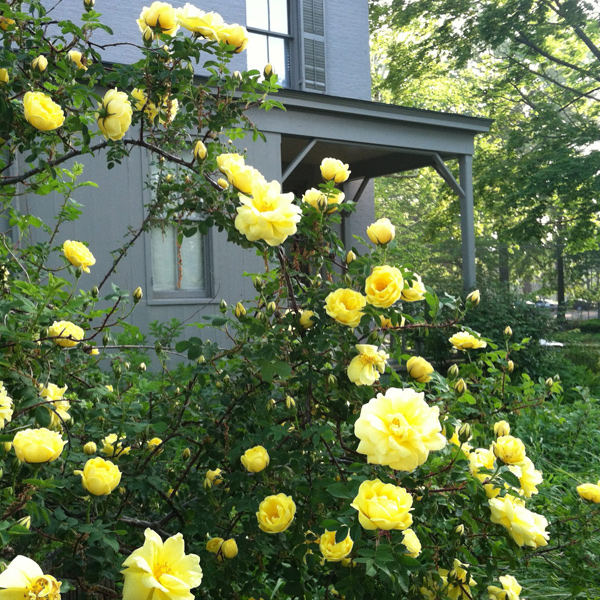You will leave feeling inspired that you too can create positive change in the world.
Our hours are:
- Sunday – Tuesday: CLOSED
- Wednesday: 12:00 PM – 5:00 PM
- Thursday: 12:00 PM – 5:00 PM
- Friday: SEASONAL HOURS: 1:00 PM – 8:00 PM
- Saturday: SEASONAL HOURS: 1:00 PM – 8:00 PM
The Stowe Center is closed:
- General Admission (17-64): $20
- Seniors (65 +): $15
- Children (6-16), College Student (with ID): $10
- Stowe Center Member, Children under 6: FREE
- Nook Farm Neighborhood Self-Guided Audio Tour: $15
- *Museums for All (with a valid EBT card and Photo ID): $3
- * Blue Star Museums for active-duty military personnel and their families (with valid ID): FREE
- *Hartford Resident (with a valid Photo ID): FREE
*If you are participating in Museums for All, Blue Star Museums, are a Hartford Resident, or are using a Library Pass, please reserve your tour admission tickets by first calling 860-522-9258 or then emailing Info@StoweCenter.org.
77 Forest Street, Hartford CT 06105
From the North (Springfield, MA)
Take I-95 South to intersection with I-84. Take I-84 West to Sisson Avenue (Exit 46). Right onto Sisson Avenue. Right onto Farmington Avenue. Right onto Forest Street.
From the South (New Haven, New York City, etc.)
Take I-91 North to the junction with I-84. Take I-84 West to Sisson Avenue (Exit 46) then follow directions from the north.
From the East (Boston, etc.)
Take I-84 West to Sisson Avenue (Exit 46) then follow the directions from the north.
From the West (New York City via I-84, Danbury, etc.)
Take I-84 West to Sisson Avenue (Exit 46) then follow the directions from the north.
Parking lot available
Street parking is available on the left side of Forest Street from Farmington Avenue (one way street). Additional parking is available at the Mark Twain House lot at 385 Farmington Ave, Hartford.
CT Transit buses 60, 62, 64, and 66 connect The Harriet Beecher Stowe Center with downtown Hartford and West Hartford Center. A transit shelter is located adjacent to the museum at Farmington Avenue and Gillett Street.
Because the Stowe Center is comprised of 19th century landscape and buildings, some ADA adjustments require advance arrangements for the best experience for your group. Please indicate if we can provide accommodations and services in advance by calling 860.522.9258, or send an email to tickets@stowecenter.org
The first floor of the Visitor Center (which includes the ticketing desk and museum store) is wheelchair accessible with an ADA restroom available.
The first floor of the Stowe House is accessible to non-electric wheelchairs. A portable ramp allows visitors to bypass the porch steps to access the building. The house tour itself includes one flight of stairs, and so the second story of the home is not accessible to wheelchair users. For folks unable to use stairs, we offer an alternative tour that provides digital images and information about the upper floor, provided by a staff member.
The Stowe Center is undertaking a major renovation to our grounds and Visitor Center that will vastly improve the accessibility of our campus.
Large backpacks, gum, food, and beverages are not permitted in the Stowe House.
Visitors are welcome to picnic on the grounds.
- No flash photography is allowed in the Stowe House.
- No videos are allowed to be taken inside the Stowe House.
- All images taken on tour must be for personal use.
- If any images are taken for commercial purposes (news outlet, tv segment, documentary, etc), please email research@stowecenter.org for Permission to Photograph contract.
Walk in the footsteps of Harriet Beecher Stowe, internationally famous author of anti-slavery novel Uncle Tom’s Cabin. Her 1871 home — now a National Historic Landmark — reflects Stowe’s Victorian decorating choices and includes modern galleries and interactive spaces connecting Stowe’s work to the present.
Freshly restored in 2017, Hartford’s Stowe House is the place to learn about Stowe’s life and work and the worldwide impact of Uncle Tom’s Cabin.
The Stowe House Experience, with conversations connecting the past to present social issues, will leave you inspired, like Stowe, to use your words to change the world.
The Harriet Beecher Stowe House was commissioned in 1871 as a spec house by Franklin Chamberlin, a wealthy Hartford lawyer. The design likely comes from a published plan. Stowe purchased the property in 1873, and in May of that year, moved in with her husband and adult twin daughters. The family remained there for the last 23 years of Stowe’s life.
After Stowe’s death in 1896 at the age of 85, the house passed out of family hands until 1924, when it was purchased by Stowe’s grand-niece, Katharine Seymour Day. Day lived in the Stowe house from 1927 until her death in 1964. During those years, Day collected manuscripts and objects connected to her famous aunt, Uncle Tom’s Cabin, and the house’s Hartford neighborhood, Nook Farm. In 1968, after extensive renovation, the Harriet Beecher Stowe House opened to the public as a museum.
In 2016/2017, the Harriet Beecher Stowe House underwent its first major interior renovation in nearly 50 years. Updates include a modern climate control system, state-of-the-art fire suppression, restored windows, and refreshed historic finishes inspired by Stowe.
Make the Stowe Visitor Center your first stop when you arrive on campus. Here you can purchase tickets for the Stowe House Experience and explore resources for taking action on social issues that matter to you.
Located inside the Visitor Center, allow time to shop in the Museum Shop: New Dawn Bookstore by River Bend Bookshop.
Your purchases support programs and preservation.
The 1873 Visitor Center was once the carriage house for the Katharine Seymour Day House.
Katharine Seymour Day (1870-1964) was Harriet Beecher Stowe’s grandniece. An ardent preservationist and activist, Day founded the Harriet Beecher Stowe Center in 1941. That same year she purchased the gilded age mansion adjacent to the Stowe House to save it from demolition.
Now named in her honor, the Katharine Seymour Day House holds the Stowe Center Research Library, administrative offices, and collections storage. It is periodically open to the public for exhibits, programs, and tours.
Katharine Seymour Day House History
The 1884 structure, built in the Queen Anne or Aesthetic style, was designed by architect Francis H. Kimball for Franklin and Mary Chamberlin. Kimball was later a successful commercial architect in New York.
The wood and granite exterior features an eclectic mix of turned balusters and porches, a variety of windows, and multiple balconies. The original exterior paint scheme, roof shingles, crestings, and finials were restored in 2002.
The Stowe Center Research Library offers access to a significant and substantial collection of material related to the Beecher and Stowe extended families, members of the culturally significant Hartford, CT Nook Farm neighborhood, and Harriet Beecher Stowe’s groundbreaking novel Uncle Tom’s Cabin.
Collections include more than 12,000 books, 4,000 pamphlets, and 180,000 manuscripts, as well as 12,000 images – photographs, prints, broadsides, posters and drawings.
The Library is open by appointment only from 9:30 AM to 4:30 PM, Monday through Friday. To schedule, contact the Director of Collections and Research at 860.522.9258 x313 or Research@StoweCenter.org
Stowe was an enthusiastic gardener, creating and tending flower and vegetable gardens at all her homes and publishing numerous gardening articles and poems.
Inspired by her writing, the Stowe Center gardens feature many of the plants she loved and wrote about in her books and letters. The design is also inspired by period photographs and her own artwork. Garden beds are planted informally, with a vibrant mix of ornamental and edible plants, shrubs, and flowering trees in a variety of colors. Among Stowe’s favorites were sweet peas, peonies, foxglove, bee balm, nasturtium, daylilies, marigolds, petunias, asters, and goldenrod. In all her garden designs, Stowe strived for mass plantings in bright colors so there is always something in bloom from April through September, beginning with spring bulbs and followed by a succession of seasonal blooms.
The gardens also include Connecticut’s largest Star Magnolia; grafts from The Stowe Dogwood, a pink variety believed to be from Stowe’s time; 100-year old American and Copper Beech, Oak and Tulip trees, and The Garden Club of America award-winning heritage roses.
The Stowe Center is part of Connecticut’s Historic Gardens, a group that includes sixteen distinctive historic sites and gardens, all within Connectictut’s borders.
19th century Nook Farm was home to writers, politicians, reformers, and activists.
Two residents, Harriet Beecher Stowe and Mark Twain, were international celebrities. Others included Isabella Beecher Hooker, Stowe’s sister and women’s rights activist; Charles Dudley Warner, author; and William Gillette, actor and playwright.
Today, several 19th-century buildings remain including the homes of Harriet Beecher Stowe and Mark Twain.
The Mark Twain House & Museum is located next door to the Harriet Beecher Stowe Center. A National Historic Landmark, the Twain House was the home to author Samuel Clemens (a.k.a. Mark Twain) and his family from 1874 to 1891.
See two National Historic Landmarks in one day: The Twain House offers public tours, school programs, and special events. More information: MarkTwainHouse.org
The Gallery for Hope & Freedom
In the Stowe House is the newly reinterpreted Gallery for Literary Activism. The Gallery can be viewed during Inspiring Stowe – 60 min tour.
The Gallery for Literary Activism
In the Stowe Visitor Center, artwork by Bloomfield resident David Jackson will be on display from May to December, titled Revolutionary [Re]Imagining: Literary Activism Through Visual Art. The Gallery is free and open to the public during open hours.
“This exhibit explores the intersection of art, literature, and justice—featuring powerful visual tributes to figures like Maya Angelou, Nelson Mandela, James Baldwin, and Tupac Shakur.” – David Jackson, Artist & Co-Curator of Revolutionary [Re]Imagining
Revolutionary [Re]Imagining is made possible in part by:











